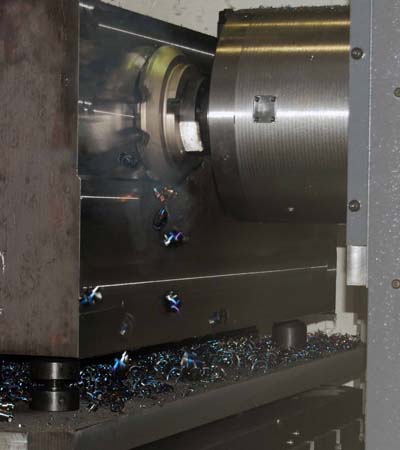
MAG's new high-torque T-Rex spindle, available on four-axis HMC 1250/1600 machines, can deliver up to 2600 Nm (1,918 lb-ft) torque into a cut to produce extreme metal removal rates on large workpieces of hard materials, such as titanium, Inconel, and Carpenter 465. Developed for the machining needs of aerospace, energy and heavy equipment manufacturers, the T-Rex spindle is engineered with 130mm (5.1 in) ID bearings to handle the 42.3 kN (9,500 lb) cutting thrust capability of the HMC 1250/1600 series horizontal machining centers. The T-Rex spindle is currently available on four-axis machines, configured with 80 kW (107.3 hp) driving power and two speed ranges up to 5,000 rpm.
The T-Rex spindle recently demonstrated triple the metal removal rates over previous spindle designs for an aerospace customer machining Carpenter 465 hardened to 50-52 Rc. The demonstration utilized a 75mm (3 in) diameter Harvi inserted endmill with five flutes and 13 inserts per flute. The cutting parameters were 100mm (4 in) axial depth of cut, 24mm (0.95 in) radial depth of cut, and 0.5mm/rev (0.020 ipr) feedrate.
"This cut produced an excellent surface finish with no sign of chatter and virtually no vibration, using only one-third of the available spindle power," said Pete Beyer, MAG's Director of Product Development. "The power of this spindle is so great that it easily handled the full Y-axis thrust of the demonstration machine, which can be equipped with higher torque axis motors to produce even higher metal removal rates. This power, coupled with the stiffness and vibration damping of the machine chassis, puts the HMC 1250/1600 in a class by itself for large hard-metal parts."
The HMC 1250/1600 is engineered to make short work of large parts, such as pumps, valves, turbines, off-road equipment, and rail or aerospace parts. Major machine components, including the X-bed, Z-bed and column, are cast ductile iron, with pallets up to 1600 x 2000mm, headstock and rotary table housings of gray cast iron. The 360,000-position full-contouring rotary table provides a rigid work platform, while a rugged worm gear drive with clamp securely holds axis position. Rotary table positioning accuracy is 10 arc seconds, repeatable to 5 arc seconds. Meeting industry needs for tighter part tolerances and greater machining accuracies, the HMC Series comes standard with linear scale feedback in X, Y and Z axes, providing 8µm (0.0003 in) positioning accuracy and 5µm (0.0002 in) repeatability.
Heavy-duty hardened and ground roller guide ways enable a rapid traverse rate of up to 40 m/min (1575 ipm) with high acc/dec rates, double the load capacity, and nearly 10 times the wear life of ball-type ways. Eight spindle options include: 6000 and 8000 rpm/46 kW (61.6 hp) tilt-spindles with +90/-120 degree A-axis travel; a 10,000 rpm/46 kW (62 hp) spindle; high-speed 24,000 rpm spindle; T-Rex high-torque 2600 Nm/80 kW (1918 ft lb) spindle and two live spindles (110 or 130mm diameter).
The high-torque T-Rex spindle is specially engineered for hard-metal cutting, while the live spindles extend W-axis reach by up to 800mm (31.5 in), enabling deep cavity milling to high precision with shorter, more rigid tools. Standard on the live spindle, MAG's exclusive Z-axis thermal compensation system dynamically offsets spindle growth to maintain correct axial position regardless of spindle temperature.
Contact Details
Related Glossary Terms
- centers
centers
Cone-shaped pins that support a workpiece by one or two ends during machining. The centers fit into holes drilled in the workpiece ends. Centers that turn with the workpiece are called “live” centers; those that do not are called “dead” centers.
- chatter
chatter
Condition of vibration involving the machine, workpiece and cutting tool. Once this condition arises, it is often self-sustaining until the problem is corrected. Chatter can be identified when lines or grooves appear at regular intervals in the workpiece. These lines or grooves are caused by the teeth of the cutter as they vibrate in and out of the workpiece and their spacing depends on the frequency of vibration.
- depth of cut
depth of cut
Distance between the bottom of the cut and the uncut surface of the workpiece, measured in a direction at right angles to the machined surface of the workpiece.
- endmill
endmill
Milling cutter held by its shank that cuts on its periphery and, if so configured, on its free end. Takes a variety of shapes (single- and double-end, roughing, ballnose and cup-end) and sizes (stub, medium, long and extra-long). Also comes with differing numbers of flutes.
- flutes
flutes
Grooves and spaces in the body of a tool that permit chip removal from, and cutting-fluid application to, the point of cut.
- gang cutting ( milling)
gang cutting ( milling)
Machining with several cutters mounted on a single arbor, generally for simultaneous cutting.
- inner diameter ( ID)
inner diameter ( ID)
Dimension that defines the inside diameter of a cavity or hole. See OD, outer diameter.
- milling
milling
Machining operation in which metal or other material is removed by applying power to a rotating cutter. In vertical milling, the cutting tool is mounted vertically on the spindle. In horizontal milling, the cutting tool is mounted horizontally, either directly on the spindle or on an arbor. Horizontal milling is further broken down into conventional milling, where the cutter rotates opposite the direction of feed, or “up” into the workpiece; and climb milling, where the cutter rotates in the direction of feed, or “down” into the workpiece. Milling operations include plane or surface milling, endmilling, facemilling, angle milling, form milling and profiling.
- rapid traverse
rapid traverse
Movement on a CNC mill or lathe that is from point to point at full speed but, usually, without linear interpolation.
- stiffness
stiffness
1. Ability of a material or part to resist elastic deflection. 2. The rate of stress with respect to strain; the greater the stress required to produce a given strain, the stiffer the material is said to be. See dynamic stiffness; static stiffness.







